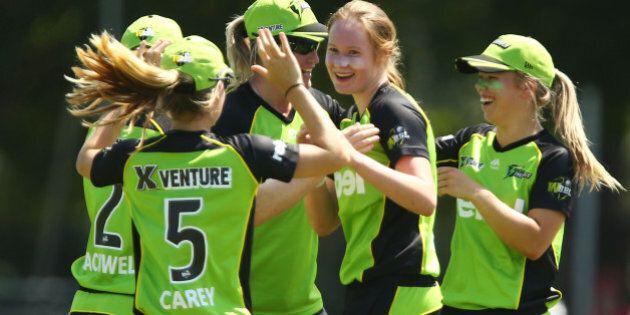
The blokey cricket is a bit of a stop-start affair on Monday with only occasional outbreaks of play interrupting the persistent showers. So let’s turn our focus to celebating the women’s game, which by any measure has made enormous strides this year.
- Women’s cricket is finally on free-to-air television and just last weekend, migrated from Ten’s digital channel, One, to Ten proper.
- That worked. The WBBL (Women’s Big Bash League Twenty20 competition) match between the two Melbourne teams on Saturday was attended by almost 13,000 people and averaged a very healthy 372,000 viewers, peaking at 404,000.
- Overall, WBBL matches are averaging around 250,000 viewers this summer. Those are big numbers for this time of year, and they comfortably beat any other men’s or women’s sport on TV right now. That includes the A-League.
- Numbers can be boring so here’s an anecdote. This reporter went to a thing a few weeks ago. The thing was a PR thing at a school run by the Commonwealth Bank. Australian captain Steve Smith and women’s cricket superstar Ellyse Perry were there. Kids went crazy lining up for autographs. But guess who created a longer line-up? Sorry, Steve. Nothing personal mate.
- There’s a cricket match each year, to which you probably pay no attention, called the PM’s XI match. Started by Sir Robert Menzies in 1951, it features a bunch of up-and-coming men’s players – plus one or two established crowd favourites – against the touring international team in Canberra.
- Well, now there’s going to be a women’s equivalent. Governor-General Peter Cosgrove today announced an annual Governor-General's XI match for female players.
But why all this progress now?
Well, your intrepid reporter is at the SCG today and has just had a lovely chat with the person right beside him in the media centre. That would be Melinda Farrell. Mel works for the world’s number one cricket website ESPNcricinfo.com and is a fantastic reporter who’s great both behind the mic and on the page.
According to Mel, it all goes back to the central contracts for women introduced by Cricket Australia three years ago.
“The professional central contracts allowed some of the women to turn professional for [Australia’s national team] the Southern Stars,” she explained.
“They also introduced contracts for state players, so players who play in the WNCL (the women’s national cricket league) now get a small retainer which is actually a huge thing.”
The planning of women’s fixtures around the world is also doing much to help the growing professionalism of the women’s game, Farrell said.
“The women have an equivalent to the men’s future tours program, where in a four-year cycle all of the cricketing have countries to play each other [at least] three times.”
Sponsorship has also played a part. As mentioned above, the Commonwealth Bank’s sponsorship covers both men’s and women’s cricket. But in its inaugural season, this year’s WBBL Twenty20 competition has stand-alone sponsorship from Rebel Sport.
But perhaps the biggest piece of the equation is media coverage. Farrell covers both men’s and women’s cricket and has travelled to England exclusively to cover the women’s Ashes. She still spends most of her time covering men’s cricket but the ratio is shifting.
"Even Wisden, which is known as the 'cricket Bible', had a women's section for the first time this year," Farrell said.
Locally, Farrell said Channel Ten and the ABC deserve credit for introducing women into their coverage.
“Channel Ten has female commentators as part of its BBL coverage and the ABC had [British broadcaster] Alison Mitchell for the pink ball test,” she said.
“I think you’ll continue to see a growth in women in the media talking about the men’s game,” she said. “If you’re talking about cricket, they play the same shots, they bowl the same types of deliveries.”
Farrell believes that the more we become accustomed to hearing women talking about any cricket -- men's or women's -- the more we'll see the women's game as a regular part of our summer sporting menu.
With our summer sporting focus about to turn to the Australian Open tennis -- where men and women are covered equally -- how long till our cricketing summer looks the same?
Five years ago you’d have said “never”. Now the answer is “soon”. Or perhaps even “not a moment too soon”.